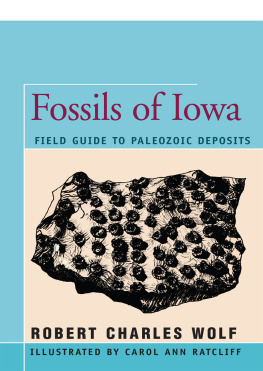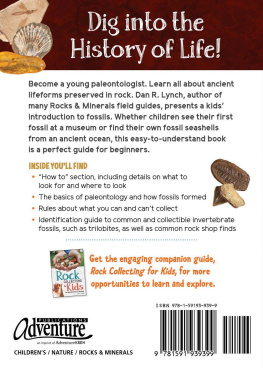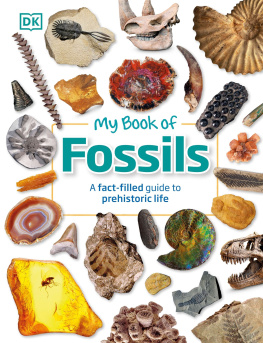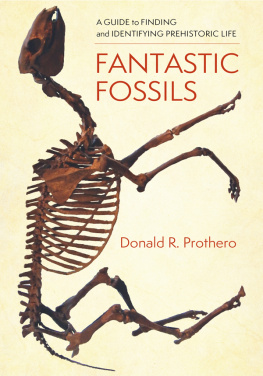Fossils of Iowa
Field Guide to Paleozoic Deposits
Robert Charles Wolf
Illustrated by Carol Ann Ratcliff

LIST OF PLATES
PREFACE
This book is a geological field guide written primarily for amateurs and students involved with paleontology. One hundred and fifty-eight sites are described throughout Iowa and adjacent parts of Nebraska and Minnesota, one hundred and fifty of which were examined in person. Two hundred geological deposits are included, to this collectors knowledge offering the most complete single coverage of Paleozoic deposits in the state.
This book incorporates several field guides published by three state geological surveys as well as other publications. In addition it shares firsthand knowledge gathered through six years of intense field work and ten additional years of amateur collecting. Most of the common and some of the rarer fossils available in the state are shown in two hundred and thirty illustrations. For the convenience of the reader, a glossary of terms used is given in the back of the book.
Those who wish to view the results of the authors collecting should visit the Sanford Museum and Planetarium in Cherokee, to which four hundred different fossil species, both fauna and flora, have been donated.
Many people do not know how much they have helped with this book. Geologists at the three state universities of Iowa, the University of Nebraska, the Minnesota Geological Survey, and the Iowa Geological Survey provided essential information and help. The Minnesota Geological Survey permitted the following illustrations to be sketched from the Guide to Fossil Collecting in Minnesota by Hogberg, Sloan, and Tufford (1967): Plate 2-7B, Plate 14-1, Plate 15-1, Plate 20-5, Plate 25-1. The Conservation and Survey Division of the University of Nebraska permitted the following illustrations to be sketched from Record in Rock by Pabian (1970): Plate 10-8; Plate 26-1, 2, 3, 4, 5, 6, 7; and from Brachiopoda of the Pennsylvanian System in Nebraska by Dunbar and Condra (1932): Plate 9-8B. The Iowa Geological Survey permitted the following illustrations to be sketched from Fossils and Rocks of Eastern Iowa by Rose (1967): Plate I-4, 5, 6B; Plate 2-7A, 8; Plate 5-4; Plate 8-5; Plate 9-3, 4; Plate 14-8; Plate 17-1A, 1B, 3, 4, 6, 10; Plate 18-4, 6A; Plate 20-9; Plate 23-1, 3, 4, 5, 6, 7; and Plate 24-1.
Thanks are owed to the following geologists, who aided me in gathering valuable field information: Phillip Heckel (University of Iowa) led a field trip to Pennsylvanian cyclothems in Madison County; Brian Witzke (Iowa Geological Survey) led a field trip to Silurian deposits in Linn and Jones counties; and Daniel Burggraf, Howard White, Robert Palmquist, and John Lemish (all of Iowa State University) led a field trip to Cherokee sandstones in Webster County.
Various civic officials, earth science teachers, fellow amateurs, and others were helpful in locating owners of several sites. Farmers and quarry owners deserve thanks for allowing collecting on private property.
The author is also grateful to those who offered moral support: friends, family members, and especially Gilbert Copper and Barbara Hartsock. People who offered help in the form of criticism or skepticism were also essential. Special thanks go to my two coauthors: Linda Dornath for the excellent typing and Carol Ratcliff for the excellent illustrations. Finally, the author thanks the Iowa State University Press for help, understanding, and perseverance.
Introduction
For over 3 billion years life has inhabited the earth, but it was very primitive for most of this history. Dramatically, during the Cambrian Period, which began about 600 million years ago, more advanced life forms began to flourish. Three hundred million years later, thick forests and swamps covered parts of the continents, reptiles and amphibians roamed the forests, and insects filled the air. The Cambrian Period marked the beginning of the Paleozoic Era, which includes the Ordovician, Silurian, Devonian, Mississippian, and Pennsylvanian periods. The Paleozoic ended with the close of the Permian Period around 225 million years ago (a span of 375 million years).
Cambrian fossils from Iowa include burrows, trilobite fragments, and brachiopods. Burrows are very common and occur in several formations. Trilobite fragments are not very abundant and are usually only small pieces. Most of the brachiopods are inarticulates, but early orthids have been found. Cambrian fossils are more common in Minnesota and Wisconsin.
Fossils from the Ordovician Period in Iowa include a wide variety of marine organisms. Most orders of brachiopods can be found, but orthids and strophomenids are the most common. Other common fossils include echinoderm debris, nautiloids, gastropods, trilobites, corals, graptolites, pelecypods, and several others.
Iowa Silurian fossils include several types of brachiopods, the most conspicuous being the pentamerids. Stromatoporoids, a wide variety of corals, nautiloids, echinoderm debris, and other fossils can also be found.
The Devonian fossils from Iowa include many types of marine organisms. Spiriferid brachiopods, corals, echinoderms, stromatoporoids, and other fossils, including fish teeth, can be found. Some collecting sites exposing Devonian formations are quite famous for their well-preserved fossils.
Fossils from the Mississippian Period in Iowa include abundant brachiopods (of which the spiriferids are the most common), bryozoans, corals, pelecypods, fish teeth, gastropods, and echinoderm debris; several other forms can also be found. Iowa is famous for well-preserved Mississippian crinoid crowns. These occur mostly in the Hampton, Gilmore City, and Burlington formations.
Pennsylvanian fossils from Iowa include both flora and fauna. Abundant plant fossils occur in the Caseyville Formation and the Cherokee Group. Marine fossils are abundant mainly in the southwestern part of the state and include several types of brachiopods (mostly strophomenids, including productids and chonetids), pelecypods, gastropods, echinoderm debris, corals, bryozoans, fusulinids, nautiloids, trilobites, and several others.
During the latter half of the Paleozoic Era, beginning in the Devonian Period, North America, Europe, and parts of Africa and South America were joined into one continental mass. Seas frequently invaded the inner regions of the continent, and Iowa was flooded many times. In the Pennsylvanian and Permian periods, the rising and falling water levels of the seas were markedly rhythmic, forming cyclic deposits of alternating shales and limestones.
The Permian Period saw the rise of early, large reptiles that were the ancestors of mammals, and further advancements of marine and plant life occurred. However, by the start of the Mesozoic Era many life forms had become extinct, including several types of brachiopods, trilobites, eurypterids, blastoids, many types of crinoids and gastropods, and others. Most of the plants composing the Paleozoic forests soon became extinct also. There are no known Permian deposits in Iowa, but the system is well represented in some neighboring states, and the Permian System of Nebraska is briefly touched upon in this book.
This book is a field guide written for amateur fossil collectors and geology enthusiasts. Most of the Paleozoic deposits in Iowa are examined, beginning with the Cambrian Wonewoc Formation and ending with the Pennsylvanian Wabaunsee Group. Most of the sites listed are in Iowa and were examined firsthand unless otherwise noted. For collectors wishing information on additional exposures of the Paleozoic Era, the addresses of seven state geological surveys in the Midwest are given in the references. Several publications listing additional sites are also listed.











